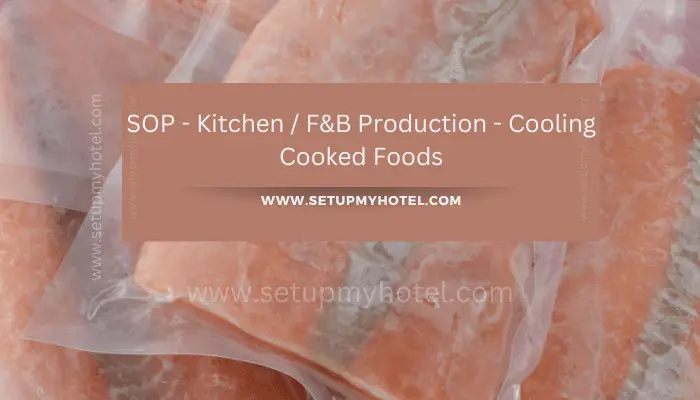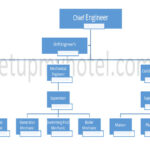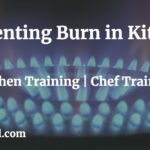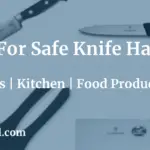How to Effectively Cool Cooked Foods in the Hotel Kitchen
When it comes to food safety, cooling cooked foods properly is just as important as cooking them to the correct temperature. In fact, improper cooling is one of the main causes of foodborne illness outbreaks. That’s why it’s crucial to follow standard operating procedures (SOPs) for cooling cooked foods in a kitchen or F&B production setting.
The first step in the SOP for cooling cooked foods is to remove the food from the heat source and transfer it to a shallow pan. This helps to increase the surface area of the food, allowing it to cool more quickly and evenly. It’s important to ensure that the food is not stacked or piled too high in the pan, as this can slow down the cooling process.
Once the food is in the shallow pan, it should be placed in a cooler or refrigerator as soon as possible. The ideal temperature for cooling cooked foods is between 135°F and 70°F, which is known as the “danger zone” for bacterial growth. To prevent the growth of harmful bacteria, the food should be cooled to below 70°F within two hours, and then to below 41°F within an additional four hours.
To speed up the cooling process, it can be helpful to use an ice bath or ice paddle to cool the food from the outside in. It’s important to stir the food occasionally to ensure that it cools evenly. Once the food has reached the proper temperature, it can be covered and stored in the refrigerator until it is ready to be reheated and served.
When cooked food is not served right away to the guest or is left over and can be saved later, it must be cooled as quickly as possible to prevent microbial growth. The temperatures of the cooked food should be taken during the cooling process to make sure that time and temperature standards are met to ensure the safety of food served to customers.
Following these SOPs for cooling cooked foods can help to ensure the safety and quality of the food being served to customers. By taking the time to cool food properly, kitchen and F&B production staff can help prevent foodborne illness outbreaks and keep their customers happy and healthy.
The Executive Chef and the Sous Chef should be responsible for ensuring that the hot foods are cooled down using appropriate practices and procedures to ensure food safety and sanitation. The hotel management should develop and implement proper written Kitchen SOP’s to ensure the same is implemented correctly throughout all the food preparation outlets.
Cooling Cooked Foods Standard Procedures:
There are two main acceptable methods of cooling food 1) The One-Stage Method and 2) the Two-Stage Method, other methods are also used to cool down the cooked foods. The chefs or kitchen employees who are involved in the cooling process of food must observe and follow the correct cooling procedures:
One-stage (four hours) method:
- To cool down hot cooked food from 57º CelsiusCelsius - The thermometric scale on which 0� Celsius is the freezing point and 100� Celsius is t... to 5º Celsius within four hours using an appropriate procedure.
- Take the temperatures of the product after four hours to make sure that the food temperature is below 5º Celsius.
- Record the temperatures on the cooling log a regular intervals.
- Make sure to reheat food to above 57º Celsius if food has not cooled to 5º Celsius in four hours.
Two-stage method:
- Cool hot cooked food from 57º Celsius to 21º Celsius or lower within two hours.
- Once it reaches 21º Celsius then cool down to 5º Celsius or lower within an additional four hours, for a total cooling time of six hours, using an appropriate procedure.
- Take temperatures at the two and six-hour intervals to make sure that the appropriate temperatures were reached.
- Reheat food to above 74º Celsius if food has not cooled to 5º Celsius in four hours.
- This particular method allows six hours to cool in the first two hours of cooling the food is passed through part of the temperature danger zone where the growth of microorganisms is most likely to occur.
Other Methods for Cooling Foods:
- By reducing the quantity of the food being cooled.
- Cutting large food items into smaller pieces or dividing large containers of food into smaller containers.
- By using a blast chiller or tumble chillers to cool food before placing it into refrigerated storage.
- By using ice-water baths.
- Divide cooked food into shallow pans or smaller pots then place them in ice water and stir food items frequently.
- Add ice or water as an ingredient while preparing foods, This works for foods that contain water as an ingredient, such as a soup or stew.
- The recipe can initially be prepared with less water than is required.
- Cold water or ice can then be added after cooking to cool the product and to provide the remaining water required in the recipe.
- StirStir: Mixing ingredients gently; using a circular motion with a spoon or whisk to ensure even cookin... food to cool faster and more evenly. Ice paddles (plastic paddles that are filled with water and frozen) and chill sticks can be used to stir food through the cooling process.
- Stirring food with these cold paddles chills food quickly as this acts as an internal ice bath.
Training Summary questions:
Q1. What is the purpose of this SOP?
Q2. Who is responsible to check and monitor the correct cooling of cooked foods?
Q3. What are the two main methods of cooling hot foods?
Q4. Provide a few other methods for cooling foods quickly.
Q5. Why it is important to reheat the food to above 57º Celsius if food has not cooled to 5º Celsius in four hours?
Patreon Only SOP Download
SOP Number: Kitchen / F&B Production SOP – 13 Department: Kitchen / Food Production - Cooling Cooked Foods Date Issued: 4 - Nov -2018 Time to Train: 30 Minutes












